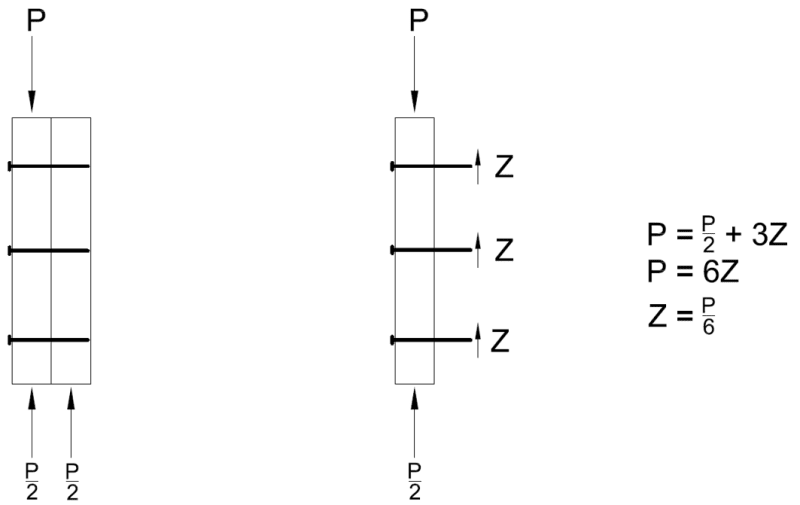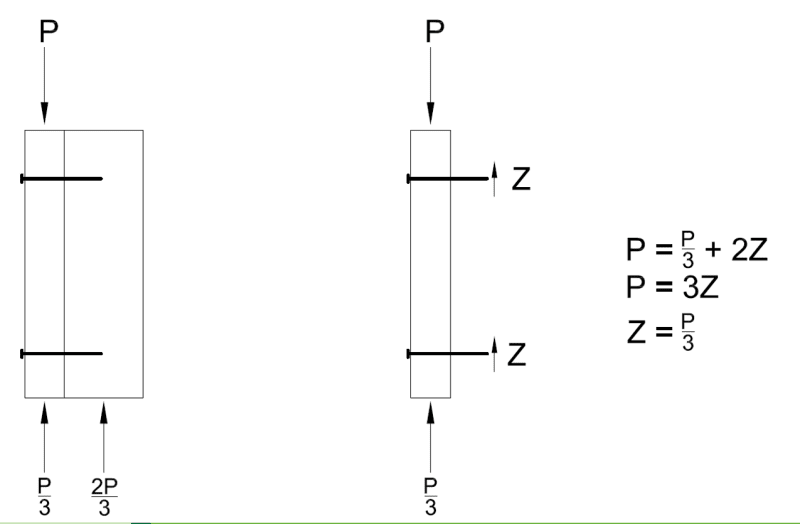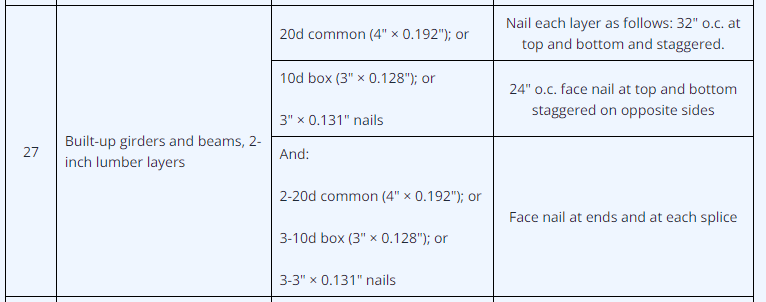How would you go about calculating the number/spacing of fasteners required to create a multi-ply wood beam such as a 2-2x10 with the 9.25" side vertical and the fasteners horizontal? I'm aware that there are prescriptive requirements for this situation and details provided by manufacturers such as Simpson and Weyerhaeuser, but I'm having a hard time understanding how one would do the calculations. If the multi-ply beam was oriented such that the 9.25" side was horizontal and the fasteners were vertical, one could look at the shear flow at the interface between the beams, but I'm not sure about this situation. My feeling is that fasteners wouldn't matter much if the beam was loaded from the top, but it certainly would if the beam was loaded from the face as with face-mounted joist hangers. Any help is appreciated!
Navigation
Install the app
How to install the app on iOS
Follow along with the video below to see how to install our site as a web app on your home screen.
Note: This feature may not be available in some browsers.
More options
Style variation
-
Congratulations MintJulep on being selected by the Eng-Tips community for having the most helpful posts in the forums last week. Way to Go!
You are using an out of date browser. It may not display this or other websites correctly.
You should upgrade or use an alternative browser.
You should upgrade or use an alternative browser.
Multi-ply Wood Beam Fastener Calculation 1
- Thread starter TAB_HOO
- Start date
- Status
- Not open for further replies.
- Thread starter
- #3
I may be missing something, but the way you have it drawn the moments don't sum to zero. You have a torsional moment that has to be resolved with tension in the fastener(s) and compression between the plies, right? Are the P's that are directed upward in your drawing internal shear forces?
Here are my thoughts, let me know if you think I'm wrong:
In order for the multi-ply beam to behave like a single beam, each ply has to have the same deflection. That deflection would also have to be equal to the deflection of a solid section of equivalent cross-section to the multi-ply beam. This means that the load taken by each ply would be distributed proportionally to each ply's share of the flexural rigidity (E*I) of the solid section. If the load is applied to one ply only, the portion of the load that the other plies are "responsible for" must be transferred through the fasteners to the other plies? Does that make sense? I'm still not sure about the torsional moment though.
Here are my thoughts, let me know if you think I'm wrong:
In order for the multi-ply beam to behave like a single beam, each ply has to have the same deflection. That deflection would also have to be equal to the deflection of a solid section of equivalent cross-section to the multi-ply beam. This means that the load taken by each ply would be distributed proportionally to each ply's share of the flexural rigidity (E*I) of the solid section. If the load is applied to one ply only, the portion of the load that the other plies are "responsible for" must be transferred through the fasteners to the other plies? Does that make sense? I'm still not sure about the torsional moment though.
-
1
- #4
driftLimiter
Structural
@TAB HOO
I use the proportionality of EI/L when needed for this. Never considered the fasteners resisting the torsional moment.
If you are just sistering the same plies of lumber then EI is consistent and you get easy distributions otherwise I come up with factors based on the ratio of EI.
Simpson uses has a screw specifically for fastening this, and they show increased fasteners at locations of point loads, and also differentiate between top loaded, front face loaded, and back face loaded.
I generally try to come up with a pattern that avoids needing special detail at different locations. But sometimes you may waste a lot of effort getting that to work.
I use the proportionality of EI/L when needed for this. Never considered the fasteners resisting the torsional moment.
If you are just sistering the same plies of lumber then EI is consistent and you get easy distributions otherwise I come up with factors based on the ratio of EI.
Simpson uses has a screw specifically for fastening this, and they show increased fasteners at locations of point loads, and also differentiate between top loaded, front face loaded, and back face loaded.
I generally try to come up with a pattern that avoids needing special detail at different locations. But sometimes you may waste a lot of effort getting that to work.
I suppose fundamentally you are correct, we are assuming an analysis for shear only. What's the magnitude of the torsional load onto such a member, and is the local pull-out a bigger concern than global torsional stability of the built-up member? Generally speaking, the torsional load is limited.TAB_HOO said:the way you have it drawn the moments don't sum to zero
If we assume a worst case scenario, where joists are hangered into the side of one of the plies, we induce an eccentric load, but the joists that are hangered also provide torsional restraint. The built-up beam should also be braced for LTB checks by the designer.
The 'P' at the top is the force we are calculating for, the 'P' at the bottom is the reaction that is assumed to be resolved through each member. For the 2-ply member of matching thickness, I assume each ply has the same EI, and therefore, half the load is resolved as a reaction in the left ply, and half the load is resolved in a reaction on the right ply.TAB_HOO said:Are the P's that are directed upward in your drawing internal shear forces?
For the second example where one ply is larger, I ratio the reaction based on the EI, since the right member is twice as thick, it carries twice as much load.
The 'P' that is directed upward is intended to show the load that stays within the ply, and is not transferred through the fasteners to the adjacent ply.
Correct. The load is transferred as shear through the fasteners. The fasteners are only responsible to transfer the load that is to be carried by the unloaded plies. The fasteners do not need to transfer all of the load experienced by the outer ply, since the outer ply will support some of the loading with or without the fasteners.TAB_HOO said:In order for the multi-ply beam to behave like a single beam, each ply has to have the same deflection.
- Thread starter
- #7
- Thread starter
- #11
TAB_HOO: yep, those are the bare minimums. Regardless of your calculations, the fastening between plies should be at least what is in the IRC table (or IBC table if it's a commercial job). But if you calculate the need for more - side loaded beam, point loads, etc. - then you have to put more in.
Chorasden's image is really good. I usually specify construction adhesive between the plies as well. The torsion is typically minimal unless you're dealing with a 4 or 5 ply side loaded beam. In that case, use screws or ring shank nails in lieu of smooth shank nails. That plus the adhesive is enough for me to not concern myself with it.
Times I do think about it: up-stand beams in an attic that don't have their top edge continually braced, grillage type arrangements, or other less-than-traditionally-braced applications.
Chorasden's image is really good. I usually specify construction adhesive between the plies as well. The torsion is typically minimal unless you're dealing with a 4 or 5 ply side loaded beam. In that case, use screws or ring shank nails in lieu of smooth shank nails. That plus the adhesive is enough for me to not concern myself with it.
Times I do think about it: up-stand beams in an attic that don't have their top edge continually braced, grillage type arrangements, or other less-than-traditionally-braced applications.
- Status
- Not open for further replies.
Similar threads
- Locked
- Question
- Replies
- 5
- Views
- 3K
- Replies
- 124
- Views
- 34K
- Replies
- 4
- Views
- 7K
- Replies
- 28
- Views
- 4K
- Locked
- Question
- Replies
- 1
- Views
- 1K





